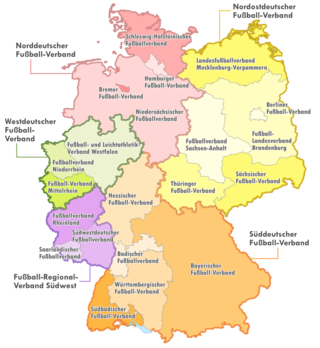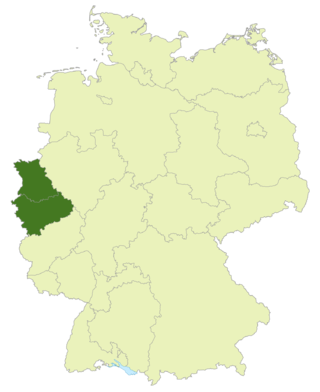Related Research Articles

The DDR-Oberliga was the top-level association football league in East Germany.

The Oberliga is the fifth tier of the German football league system. Before the introduction of the 3. Liga in 2008, it was the fourth tier. At the end of the 2011–12 season the number of Oberligas was increased from eleven to fourteen.

The Oberliga is the third tier of ice hockey in Germany, below DEL2 and ahead of the Regionalliga. Since the 2015/16 season, the league has been split into two regionalised divisions, Nord (north) and Süd (south). The Oberliga was originally founded in 1948 and is administered by the German Ice Hockey Federation (DEB).
The NOFV-Oberliga is a division at step 5 of the German football league system. After the fall of the Berlin Wall, it became the successor of the DDR-Oberliga, and functions today as a 5th division in the former territory of East Germany and the city of Berlin.

Hallescher FC, formerly known as Chemie Halle, is a German association football club based in Halle an der Saale, Saxony-Anhalt. The club currently plays in the 3. Liga, the third highest level in the German football league system.
The German football league system, or league pyramid, refers to the hierarchically interconnected league system for association football in Germany that in the 2016–17 season consisted of 2,235 leagues in up to 13 levels having 31,645 teams, in which all divisions are bound together by the principle of promotion and relegation. The top three professional levels contain one division each. Below this, the semi-professional and amateur levels have progressively more parallel divisions, which each cover progressively smaller geographic areas. Teams that finish at the top of their division at the end of each season can rise higher in the pyramid, while those that finish at the bottom find themselves sinking further down. Therefore, in theory, it is possible for even the lowest local amateur club to rise to the top of the system and become German football champions one day. The number of teams promoted and relegated between the divisions varies, and promotion to the upper levels of the pyramid is usually contingent on meeting additional criteria, especially concerning appropriate facilities and finances.

The Oberliga Rheinland-Pfalz/Saar, formerly the Oberliga Südwest, is the highest regional football league for the Rhineland-Palatinate and Saarland states of Germany, organized by the Southwestern Regional Football Association. It is the fifth tier of the German football league system. It is one of fourteen Oberligas in German football, the fifth tier of the German football league system. Until the introduction of the 3. Liga in 2008 it was the fourth tier of the league system; before the introduction of the Regionalligas in 1994 the third tier.

The Oberliga Baden-Württemberg is the highest association football league in the state of Baden-Württemberg and the Baden-Württemberg football league system. It is one of fourteen Oberligas in German football, the fifth tier of the German football league system. Until the introduction of the 3. Liga in 2008 it was the fourth tier of the league system, and until the introduction of the Regionalligas in 1994 the third tier.

The Hessenliga is the highest football league in the state of Hesse and the Hessian football league system. It is one of fourteen Oberligas in German football, the fifth tier of the German football league system. Until the introduction of the 3. Liga in 2008 it was the fourth tier of the league system, until the introduction of the Regionalligas in 1994 the third tier.
The Oberliga Süd was the southernmost of the five Oberligen, the regional leagues forming the top level of association football in West Germany from 1945 until the formation of the Bundesliga in 1963. Oberliga Süd covered the southern three German states of Bavaria, Baden-Württemberg and Hesse.

The Oberliga Südwest was the highest level of the German football league system in the southwest of Germany from 1945 until the formation of the Bundesliga in 1963. It covered the two states of Rhineland-Palatinate and Saarland.
The Oberliga Berlin, sometimes also referred to as Stadtliga Berlin or Vertragsliga Berlin was the highest level of the German football league system in the city of West Berlin in West Germany from 1945 until the formation of the Bundesliga in 1963. It was by far the smallest of the five Oberligas.

The Oberliga Nordrhein was the highest Football League in the region of Nordrhein which is part of the state of North Rhine-Westphalia from 1978 to 2008. In its last season, it was one of nine Oberligas in German football, the 4th tier of the German football league system. In 2008, it was replaced by the NRW-Liga, a new statewide league.

The Oberliga Nord was the fourth tier of the German football league system in the north of Germany. It covered the states of Lower Saxony, Bremen, Hamburg and Schleswig-Holstein. With the introduction of the 3. Liga, the league ceased to exist from 2008.
The NOFV-Oberliga Nord is the fifth tier of the German football league system in the northern states of the former East Germany and West Berlin. It covers the German states of Berlin, Brandenburg, Mecklenburg-Western Pomerania and northern Saxony-Anhalt. It is one of fourteen Oberligas in German football. Until the introduction of the 3. Liga in 2008 it was the fourth tier of the league system, and until the introduction of the Regionalligas in 1994 the third tier.
The NOFV-Oberliga Süd is the fifth tier of the German football league system in the southern states of the former East Germany. It covers the German states of Saxony-Anhalt, Thuringia, Saxony and southern Brandenburg. It is one of fourteen Oberligas in German football. Until the introduction of the 3. Liga in 2008 it was the fourth tier of the league system, and until the introduction of the Regionalligas in 1994 the third tier.

The DDR-Liga was, prior to German reunification in 1990, the second level of football competition in the DDR, being roughly equivalent to the 2. Bundesliga in West Germany.

Hertha BSC II is the reserve team of Hertha BSC that is based in Berlin, Germany. Historically, during the time the senior team played in professional football the team has played as Hertha BSC Amateure. Since 2005 it permanently plays under its current name.
The 1955 DDR-Oberliga was the seventh season of the DDR-Oberliga, the first tier of league football in East Germany. After the 1954–55 season the league played a transition round in autumn 1955, followed by five seasons, until 1960, where it played in the calendar year format. From 1961–62 onwards the league returned to its traditional format.
The 1989–90 DDR-Oberliga was the 41st season of the DDR-Oberliga, the first tier of league football in East Germany. It was the last season of the league under the name of DDR-Oberliga as it played as the NOFV-Oberliga in the following season. East Germany saw great political change during the 1989–90 season with the opening of borders in October 1989, free elections in March 1990 and the eventual German reunification later in the year.
References
- Müller, Stephan (2000). Deutsche Eishockey Meisterschaften. Germany: Print on Demand. ISBN 3-8311-0997-4.